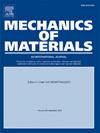均匀基板上的梯度热电薄膜的热应力分析
IF 3.4
3区 材料科学
Q2 MATERIALS SCIENCE, MULTIDISCIPLINARY
引用次数: 0
摘要
本文研究了附着在均匀衬底上的功能梯度热电薄膜的热弹性行为。首先假设一维温度场,利用控制热电材料物理特性的方程得到稳态温度分布。然后,结合平衡方程和应变协调方程,导出了该问题的积分方程。由于粘接层的抗拉强度远小于薄膜和基体的抗拉强度,因此采用简单的剪切变形。最后,采用高斯-切比雪夫离散化方法,求解了界面应力分布的积分方程。对非均匀性参数对薄膜和衬底应力分量的影响进行了详细的参数研究。数值计算结果表明,适当调整功能梯度热电薄膜的非均匀性参数可以延长器件的使用寿命和机械稳定性。此外,选择较软和/或较厚的粘合层可以减少薄膜末端附近的应力集中以及分层边缘。当分层长度超过薄膜长度的40%时,界面剪应力分布发生方向性变化。在弹性衬底上沉积较薄的热电薄膜可以延缓由界面剪切应力引起的分层破坏。本文章由计算机程序翻译,如有差异,请以英文原文为准。
Thermal stress analysis in a graded thermoelectric film bonded to a homogeneous substrate
In this paper, the thermoelastic behavior of a functionally graded thermoelectric thin film attached to a homogeneous substrate is investigated. First assuming a one-dimensional temperature field, the steady-state temperature distribution is obtained using the equations governing the physics of thermoelectric material. Then, the integral equations are derived for the problem by combining the equilibrium and strain compatibility equations. The simple shearing deformation is adopted for the bonding layer since its tensile strength is much smaller than that of the film and the substrate. Finally, employing the Gauss-Chebyshev discretization method, the integral equation is solved for the interfacial stress distribution. A detailed parametric study is conducted to explore the effect of non-homogeneity parameters on the stress components for the film and the substrate. The numerical results indicate that proper adjustment of the non-homogeneity parameters for the functionally graded thermoelectric thin film can extend the service life and the mechanical stability of the device. Additionally, choosing a softer and/or thicker bonding layer can reduce the stress concentration near the film ends as well as the delamination edges. The interfacial shear stress distribution changes direction when the delamination length exceeds 40% of the film length. Depositing a thinner thermoelectric film on an elastic substrate can delay delamination failure driven by interfacial shear stress.
求助全文
通过发布文献求助,成功后即可免费获取论文全文。
去求助
来源期刊

Mechanics of Materials
工程技术-材料科学:综合
CiteScore
7.60
自引率
5.10%
发文量
243
审稿时长
46 days
期刊介绍:
Mechanics of Materials is a forum for original scientific research on the flow, fracture, and general constitutive behavior of geophysical, geotechnical and technological materials, with balanced coverage of advanced technological and natural materials, with balanced coverage of theoretical, experimental, and field investigations. Of special concern are macroscopic predictions based on microscopic models, identification of microscopic structures from limited overall macroscopic data, experimental and field results that lead to fundamental understanding of the behavior of materials, and coordinated experimental and analytical investigations that culminate in theories with predictive quality.
 求助内容:
求助内容: 应助结果提醒方式:
应助结果提醒方式:


